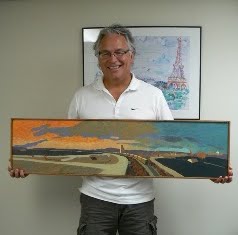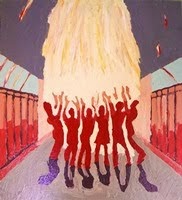PHOTOS BELOW. Chillicothe Business College mural, painted from a scissors-lift three stores up. The full space was 100 foot wide. Ten foot illustrations was course work offered at that turn-of-the-century school.
--- The Karl from 2014 is melding with the Karl from 1998 and the Karl from 1977. What a rendezvous. the VAST INTENSITY joy undivided is stitching my memories into one person. that PHAT PHISH. beautiful FIRE. my king and lord jesus. from a 1996 journal entry entreats me to: DELIGHT IN HIM, speak of him, SING TO HIM, let my tears be on display, be a model of tenderness, be open, be gentle.
--- I remember what Danielle Sullivan told me about the red plastic tear drop, with the bright glitter outline, in the middle of blue felt jesus hands. she said: "THAT US. WE ARE IN THE WOUNDS OF JESUS. THAT IS WHERE HE HEALS US." that nine year old observation, so fresh and real.
--- The night I woke up at two o'clock in the morning to record on paper what he pointed out to me from that night's movie at the Uptown Theater in Carrollton. As Bud of Pleasantville told the students in the soda shop about his experiences "outside Pleasantville," the blank book pages came to life. How the roads are not a circle path, but they go on and on. He declared an experience greater-than-you-have-ever-known with jesus and the wonderful drenching rain of the spirit and the beauty of jesus ( full text at http://karl.marxhausen.net/pleasantville.html )
Carrollton sculptor Robert Willis ABOVE mounts his welded shovel bird at 1999 Beautiful Fire exhibit, 5 East Benton Street, Carrollton. That exhibit was sponsored by That Phat Phish coffeehouse, for a one-day event.
--- it was my chat with wayne, something my youth group wrote on paper, the VAST INTENSITY JOY UNDIVIDED crashing mashing melding smoothing splashing into my mind and heart and being. he is ALL THAT..........and so much MORE. He stirs my senses in my 58 years old self. He embraces this porcupine, I am His and He is mine.
PHOTO BELOW, a piano break of mine, in gymnasium. One stop of many during my father's art workshop tour 1970 - 1971, around the United States when I was age 16.
PHOTO BELOW. at age 20, on my knees in the Commons room of Centennial College, surrounded by Jon Swift (upper left), Dan Swinarski (holding lamp), Tim Roper (center), Lynn Williams (upper right). my advertised happening event, tearing paper strips from discarded Lincoln phone books, tossing them up in the air, watching them flutter poetic to the floor. 1975 at the University Nebraska in Lincoln.
---- My piano self in 1977, sitting on the wooden bench of the Neihardt snack bar, next to Jon Swift, harmonizing about my neighbor Bob Popek in a warm and silly chorus. Conversing with the grown up version of Jeffrey Binder, the flute person who now is a neurologist in Wisconsin doing brain research. That friendship stretched through time and space into May of 2014. oh my lord, my phat phish, my delight, my king. you ARE so good.


















































